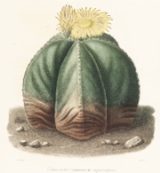
Astrophytum myriostigma
Encyclopedia
Astrophytum myriostigma (common name
s: Bishop's Cap Cactus, Bishop's Hat or Bishop's Miter Cactus) is a species
of cactus
native to the highlands of northeastern and central Mexico
.
Synonyms include Echinocactus
myriostigma, Astrophytum prismaticum, A. columnare, A. coahuilense, A. tulense, and A. nuda.
A. myriostigma is a spineless cactus defined by the presence of three to seven (usually five) pronounced vertical ribs which define the cactus' shape when young (the genus name "astrophytum", literally, "star plant", is derived from the resulting star-like shape). As the cactus ages, more ribs may be added and it becomes more cylindrical in shape, growing up to about 70-100 cm tall and 10-20 cm in diameter. The stem is often covered with whitish flecks.
The cactus flowers in the spring or summer with one or more waxy flower
s 4-6 cm diameter near its apex; the numerous petals are yellow, sometimes with an orange or red base. Pollinated
flowers develop into a hairy reddish fruit
about 2-2.5 cm in diameter. Plants may take up to six years to flower. A. myriostigma is commonly grown as an ornamental plant
in cactus collections.


. 28/7/2005. "Bishop's Miter, Bishop's Cap". www.desert-tropicals.com. 28/7/2005. photos on www.AIAPS.org. photos on www.cactiguide.com
Common name
A common name of a taxon or organism is a name in general use within a community; it is often contrasted with the scientific name for the same organism...
s: Bishop's Cap Cactus, Bishop's Hat or Bishop's Miter Cactus) is a species
Species
In biology, a species is one of the basic units of biological classification and a taxonomic rank. A species is often defined as a group of organisms capable of interbreeding and producing fertile offspring. While in many cases this definition is adequate, more precise or differing measures are...
of cactus
Cactus
A cactus is a member of the plant family Cactaceae. Their distinctive appearance is a result of adaptations to conserve water in dry and/or hot environments. In most species, the stem has evolved to become photosynthetic and succulent, while the leaves have evolved into spines...
native to the highlands of northeastern and central Mexico
Mexico
The United Mexican States , commonly known as Mexico , is a federal constitutional republic in North America. It is bordered on the north by the United States; on the south and west by the Pacific Ocean; on the southeast by Guatemala, Belize, and the Caribbean Sea; and on the east by the Gulf of...
.
Synonyms include Echinocactus
Echinocactus
Echinocactus is a genus of cacti in the subfamily Cactoideae. The generic name derives from the Ancient Greek εχινος , meaning "spiny," and cactus. It and Ferocactus are the two genera of barrel cactus. Members of the genus usually have heavy spination and relatively large flowers...
myriostigma, Astrophytum prismaticum, A. columnare, A. coahuilense, A. tulense, and A. nuda.
A. myriostigma is a spineless cactus defined by the presence of three to seven (usually five) pronounced vertical ribs which define the cactus' shape when young (the genus name "astrophytum", literally, "star plant", is derived from the resulting star-like shape). As the cactus ages, more ribs may be added and it becomes more cylindrical in shape, growing up to about 70-100 cm tall and 10-20 cm in diameter. The stem is often covered with whitish flecks.
The cactus flowers in the spring or summer with one or more waxy flower
Flower
A flower, sometimes known as a bloom or blossom, is the reproductive structure found in flowering plants . The biological function of a flower is to effect reproduction, usually by providing a mechanism for the union of sperm with eggs...
s 4-6 cm diameter near its apex; the numerous petals are yellow, sometimes with an orange or red base. Pollinated
Pollination
Pollination is the process by which pollen is transferred in plants, thereby enabling fertilisation and sexual reproduction. Pollen grains transport the male gametes to where the female gamete are contained within the carpel; in gymnosperms the pollen is directly applied to the ovule itself...
flowers develop into a hairy reddish fruit
Fruit
In broad terms, a fruit is a structure of a plant that contains its seeds.The term has different meanings dependent on context. In non-technical usage, such as food preparation, fruit normally means the fleshy seed-associated structures of certain plants that are sweet and edible in the raw state,...
about 2-2.5 cm in diameter. Plants may take up to six years to flower. A. myriostigma is commonly grown as an ornamental plant
Ornamental plant
Ornamental plants are plants that are grown for decorative purposes in gardens and landscape design projects, as house plants, for cut flowers and specimen display...
in cactus collections.


External links
"Bishop's cap cactus". Encyclopædia BritannicaEncyclopædia Britannica
The Encyclopædia Britannica , published by Encyclopædia Britannica, Inc., is a general knowledge English-language encyclopaedia that is available in print, as a DVD, and on the Internet. It is written and continuously updated by about 100 full-time editors and more than 4,000 expert...
. 28/7/2005. "Bishop's Miter, Bishop's Cap". www.desert-tropicals.com. 28/7/2005. photos on www.AIAPS.org. photos on www.cactiguide.com

